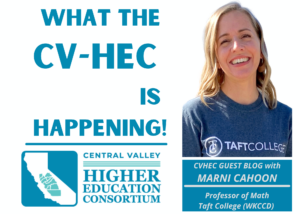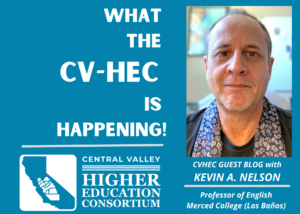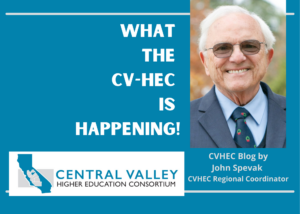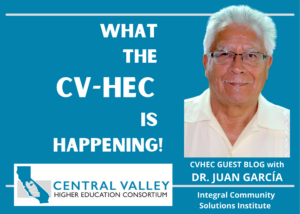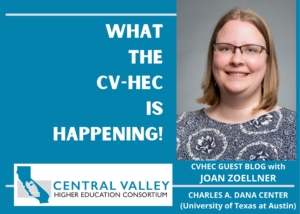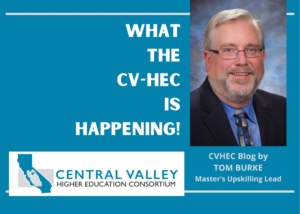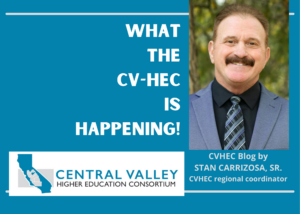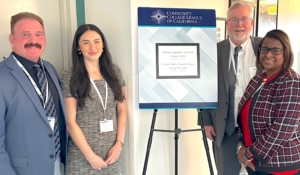This month, the Central Valley Higher Education Consortium announces the return of our Central Valley Dual Enrollment for Equity and Prosperity (CVDEEP) Task Force Convening set for Nov. 14. So for our “What the CV-HEC is Happening” Blog this issue, we take a look at one member’s approach to dual enrollment at Taft College. Marni Cahoon, M.S., adjunct instructor of mathematics for the West Kern Community College District, recounts the road the Taft College faculty traveled to establish a program that helps its students face challenges on their academic journey with a renewed sense of hope and accomplishment. An alumna of University of Alaska, Southeast, Brigham Young University and the University of West Florida, Prof. Cahoon has been teaching at Taft since 2022.
Dual enrollment: overcoming
higher ed obstacles
‘… a force for opening college opportunities to more of our students’
BY MARNI CAHOON, M.S.
Adjunct Instructor of Mathematics (Taft College – West Kern Community College District)
During the 2022-2023 school year, I had the opportunity to teach the first dual enrollment mathematics course taught through Taft College on the campus of Taft Union High School in Taft, CA. Taft is a small tight-knit community on the southwest edge of the San Joaquin Valley, and about a 45-minute drive to Bakersfield.
Historically, Taft exists because of the presence of oil fields; indeed, many are still employed in this industry. As with much of the San Joaquin Valley, there is also a strong agricultural presence here.
Before embarking on my adventures at Taft High, I sought to understand the population I would be working with. At that time the latest data available was from the 2021-2022 school year. I found that Taft High serves a predominantly minority population with over 82% of students considered socioeconomically disadvantaged. Unfortunately, the latest test scores also showed that only 9% of Taft High students tested met or exceeded state standards in mathematics.
Economic disadvantages and low test scores combined with local industries not known for encouraging college education have perhaps left Taft High students less likely or seemingly unable to pursue higher education.
I see dual enrollment as vital to overcoming obstacles to higher education within my community. With the ability for students to enroll in and take higher education courses on their own high school campus, at no monetary cost to them or their families, I hope that dual enrollment is a force for opening college opportunities to more of our students.
This first dual enrollment math course was conceived with the desire to offer Calculus I to high school seniors, particularly those with an interest in entering the highly desirable STEM fields. Because the incoming senior class had spent a few of their high school years in the middle of the COVID-19 pandemic, a dual enrollment Precalculus course was offered as a prerequisite during the fall 2022 semester to ensure students would be prepared for the rigors of Calculus I in the spring.
My students came to me having had Algebra 2 and much of their high school’s Precalculus course online. As such, they had fought through much adversity to be eligible for Calculus I. Even so, the semester of dual enrollment Precalculus was invaluable in reviewing and reteaching concepts from algebra and trigonometry. I also saw this first semester as good exposure to the expectations of a college-level math course. By the time Calculus I came around that spring semester, my students understood that our course would move at a pace much quicker than a typical high school math class and were able to plan accordingly. They also were prepared for open-ended tests, and deeper dives into critical thinking. With these benefits, it was decided to continue teaching dual enrollment Precalculus before Calculus I in subsequent years.
As I have continued to teach dual enrollment throughout the semesters, I am always impressed with my students’ abilities to rise to the demands presented to them. Although many of my students have or will become the first in their families to attend college, they are determined to succeed.
Most importantly, my students are able to start a journey of essential self-discovery. Having successfully taken a rigorous college course undoubtedly gives these students confidence in their abilities to be successful college students. Indeed, as Calculus I is often considered a gateway to STEM careers, the ability to take the course before becoming traditional college students has allowed many of my students to narrow their academic focus and have a better understanding of the direction they would like their college education, and their future careers, to take.
Most of my students have gone on to enroll in engineering programs and Calculus II after high school graduation, with several attending Taft College. Others were able to decide before entering college full-time that a STEM degree wasn’t the best fit for them, thus allowing them to start their freshman year of college in a major better suited to their interests. So far, all of my students have started college after high school graduation.
Whichever path my students ultimately end up taking after leaving my class, the ability to take college-level math courses in high school will help them transition to life as college students. They are better able to rise above the demographics of their community and position themselves to take advantage of additional higher education opportunities.

